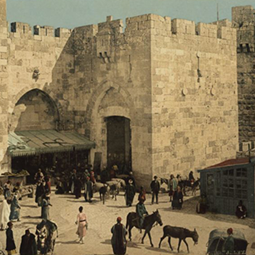There are approximately 1,220 localities in Israel, incorporated into 255 local authorities. In 2022, they consisted of about 80 cities, 122 communities referred to as "local councils" and 54 "regional councils". Approximately 90% of the residential population in Israel dwell in urban neighborhoods: about 74% of Israelis live in cities, and about 15% live in the local councils.
In 2022, Jerusalem, the capital of Israel, was considered the largest city in the country based on its population which consisted of about 971,000 inhabitants. Next in line was Tel Aviv with about 470,000 residents. The third largest was Haifa, inhabiting about 284,000 citizens, followed by Rishon LeZion, with an approximate population of 257,000. Petah Tikva was fifth with about 252,000 citizens.
For the most part, communities in Israel are considered urban when they inhabit over 2,000 residents, even if the community is defined as a local council rather than a large municipality. They are usually regarded as cities if the population exceeds 20,000. In addition to the urban dwellers, about 10% of Israelis live in rural areas and village communities that are part of regional councils, while about 0.7% reside in unincorporated communities that are not governed by municipalities.
According to data from Israel's Central Bureau of Statistics, in late 2018, there were 1,218 localities in Israel that consisted of 1,081 Jewish communities, 128 non-Jewish settlements, as well as 9 mixed communities. These figures include a total of 263 urban settlements and 955 rural communities, including kibbutzim, moshavim and community settlements. About 44% of Israelis live in 16 cities, ten of which are in the Tel Aviv and Central Districts. Most communities are linked to the four main metropolitan centers – Jerusalem, Tel Aviv, Haifa, and Be’er Sheva – which provide their respective regions with public services in the fields of government, medicine, labor, commerce, recreation and entertainment.
The History of Urban Development in Israel
Similar to the rest of the world, Israel was influenced by urbanization even prior to the establishment of the State. The attraction to urban lifestyle led to migration to the metropolitan areas. However, in Israel, other factors helped determine the nature of different settlements as well as their geographical locations, such as: the Zionist goal of establishing a Jewish state, the mass waves of immigration to Israel, the aspiration of shaping the country’s borders (prior to its establishment and after), and the attempt to safeguard the borders by establishing settlements. The diverse composition of Israeli society, with its Jewish and Arab populations and their respective subgroups, also influenced urban life in Israel, For these reasons, many communities are positioned along Israel’s borders, and some are characterized by group affiliation, whether Jewish or Arab, ultra-Orthodox or national-religious, and so forth.
In 1918, when British control of the region commenced, there were 51 established Jewish agricultural settlements. Most of these were farming colonies (moshavot) and the rest were communal settlements (kvuzot), farms, and moshavim. The urban population of the Jewish settlement resided at the time, for the most part, in Jerusalem, Haifa, Jaffa, Safed, Tiberias, and the young city of Tel Aviv. By 1948, there were 302 Jewish agricultural settlements, nearly half were kibbutzim, and the rest were farming colonies and moshavim. By the end of 1950, the State of Israel contained approximately 20 cities.
The mass waves of immigration which arrived in the country’s first decade necessitated immediate and broad housing solutions. Aside from the objective of absorbing the immigrants, the country set a goal of geographical dissemination of the population. Consequently, within 15 years, hundreds of thousands of immigrants were settled in 30 communities known as “Development Towns”, established in the Central District, in the Negev and in the Galilee. Most were new urban communities but some of the older existing settlements were also categorized as development towns. Subsequently, the program was harshly criticized for the way the towns were established and the treatment they received, including aspects of urban planning, locations, relationships with the surrounding areas, quality of service, economic infrastructure, as well as sources of income. Over the years, many of these communities were converted into cities, or incorporated into existing cities.
The National Library of Israel preserves innumerable fascinating historical materials that relay the stories of Israel’s cities and regions. Items from the Library’s collections are available for viewing, and include maps, books, photographs, postcards, posters, studies, articles, letters, historical newspaper clippings and more. Many of the items are available in digital form, and illuminate various aspects of the cities, towns, and regions of Israel.

 Sign in with Google
Sign in with Google
 Sign in with Facebook
Sign in with Facebook

